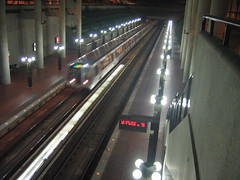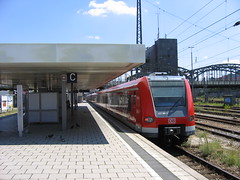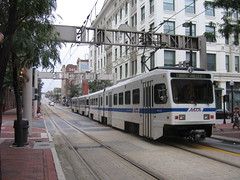Crossposted at Greater Greater Washington
Last week in my counterpoint post on the Silver Line and the viability of a Dulles Express Line using the Washington and Old Dominion Trail, I touched briefly upon the differences between American and European transit concepts. Because we don't have many words to describe a variety of systems, it can be difficult to compare and constrast different types of transit, especially those in other countries. With so few words, things get lost in translation.
As far as the Federal Transit Administration is concerned we have only a few words to describe our modes. There are certainly more variations on modes than those found in the National Transit Database's glossary. In that regard, I've tweaked the nomenclature to apply to the continuum of rail transit modes in an effort to clarify differences and group systems based on similarities.
As I pointed out in my post on the Silver Line's virtues, Spencer is correct when he calls Metro a hybrid between subways and commuter rail. Since it is a hybrid, it can't be considered purely a subway or a commuter rail system. It is indeed something in between. But the FTA doesn't consider the Washington Metro any different (as a mode) from the Boston T or the New York City Subway.
Despite the differences between pre-auto age heavy rail systems and the modern heavy rail systems, which I talked about last week, both types are considered the same mode. This is probably fine from a funding perspective, but it leaves a little to be desired when thinking about transit from a comparative perspecive. Chicago's Green Line is quite different from Washington's Green Line. The root of these differences comes from the market for which each was built. Chicago's Green Line was built mainly with walk-to-transit riders in mind, while Washington sought to cater to drivers bound for the central business district from the suburbs.
Last week in my counterpoint post on the Silver Line and the viability of a Dulles Express Line using the Washington and Old Dominion Trail, I touched briefly upon the differences between American and European transit concepts. Because we don't have many words to describe a variety of systems, it can be difficult to compare and constrast different types of transit, especially those in other countries. With so few words, things get lost in translation.
As far as the Federal Transit Administration is concerned we have only a few words to describe our modes. There are certainly more variations on modes than those found in the National Transit Database's glossary. In that regard, I've tweaked the nomenclature to apply to the continuum of rail transit modes in an effort to clarify differences and group systems based on similarities.
As I pointed out in my post on the Silver Line's virtues, Spencer is correct when he calls Metro a hybrid between subways and commuter rail. Since it is a hybrid, it can't be considered purely a subway or a commuter rail system. It is indeed something in between. But the FTA doesn't consider the Washington Metro any different (as a mode) from the Boston T or the New York City Subway.
Despite the differences between pre-auto age heavy rail systems and the modern heavy rail systems, which I talked about last week, both types are considered the same mode. This is probably fine from a funding perspective, but it leaves a little to be desired when thinking about transit from a comparative perspecive. Chicago's Green Line is quite different from Washington's Green Line. The root of these differences comes from the market for which each was built. Chicago's Green Line was built mainly with walk-to-transit riders in mind, while Washington sought to cater to drivers bound for the central business district from the suburbs.


In the comment threads which have sprouted from the various Silver Line posts from last week and this week, many comparisons have been drawn to European systems and systems in other American cities. These other systems are good places to look, because we can gain insight from the variation between modes. Europe is a particularly good place to look to add a little perspective.

Stadtbahn Stuttgart
The below graphic shows the rail transit continuum. Modes are shown with increasing "regionality" as one reads down the graph. Transit serving shorter trips (like guideways and streetcars) are on top with modes used for longer trips are on the bottom.

The Rail Transit Continnum
The graphic is not meant to be exhaustive, just to act as a frame of reference. For instance BART, while still heavy rail, is closer to a regional rail system than is Washington's Metro. And Los Angeles' Red and Purple Lines with far less suburban-serving segments are closer to the subways of the pre-auto era.
Because the distinctions are important, let's look a little more deeply at nomenclature.
- Streetcars: Streetcars often operate as single units in traffic with curb-side stops. Sometimes they have a semi-exclusive right-of-way, like a median or private ROW. They act as feeders to the regional system and mainly serve closer in nieghborhoods. Streetcars are sometimes older systems dating back many years (as with New Orleans), while modern streetcars are quite in vogue today (as in Portland and Seattle). Other cities have (re)created vintage (San Francisco) or faux-vintage (Charlotte) streetcar lines.
- Light Rail: This mode began appearing in North America in the late 1970s. Light rail offered a cheaper method to create a regional system and have become popular as substitutes to heavy rail. They serve corridors where heavy rail investment is not practical. In some cities, light rail systems take on many of the attributes of heavy rail, including downtown subways (San Francisco, Seattle) and level boarding (Charlotte).
- Subways: Systems like the New York Subway and the Chicago L are a type of heavy rail. While these types of service are certainly regional in nature, they often serve only the central municipality and not surrounding jurisdictions. Stop spacing is fairly close and speeds are slower than more regional-type services. The defining characteristic of this subset of heavy rail is that ridership is based on walk-to riders rather than drive-to riders.
- Rapid Rail: The modern heavy rail systems constructed in the 1970s, 80s, and 90s were often known as Rapid Rail. In fact, the Rs in BART and MARTA both stand for 'Rapid'. However the distinction gets a little blurry here. Rapid Rail systems typically serve the metropolitan area as a whole. Like the Washington Metro, surrounding jurisdictions have high levels of service as well. Speeds are faster than on subways and the distance between stops is higher.
- Regional Rail: Regional rail is a subset of FTA's commuter rail mode. I think of regional rail as different from commuter rail mainly based on service patterns. Regional rail trains, as their name suggests, serve whole regions. They also offer bi-directional and off-peak service in the region. One of the best examples of regional rail is the SEPTA Regional Rail network in Philadelphia. With a center city tunnel based on the S-bahn tunnels in several German cities, the network serves the central city and the suburbs with quick trips. Service headways are lower than one would find on Rapid Rail.
- Commuter Rail: Commuter rail, as I pointed out above, typically only offers peak-period, peak-direction service. In the Washington region, VRE and MARC's Brunswick Line offer good examples. MARC's Penn Line, on the other hand, acts more like regional rail.
- Other Modes: The FTA also considers Cable Cars, Inclines, Monorails, and Automated Guideways as rail modes. These tend to serve specialized and smaller markets.
- Cable Cars, for instance, can easily be grouped with streetcars, as they serve similar markets and have similar attributes.
- Inclines have very limited use, but often serve as vital links within transit systems.
- Monorails and Automated Guideway systems also tend to serve very localized markets or act as distribution systems. It is possible to build entire systems with these technologies, as is the case with Vancouver's SkyTrain, but in the United States, they tend to be limited to moving people around central business districts, as is the case in Miami and Detroit.
Looking across the pond can create confusion as well. In London, for instance, the Docklands Light Railway has dramatically improved service to East London. But the system is not light rail in the sense that most American's think of it. It would be more accurately be described as Automated Guideway Transit, which is a separate mode according to the FTA. The Docklands system, unlike most American light rail systems, is entirely grade separated.
And contributing to the idea that America and Britian are two countries separated by a common language, heavy rail in Britian denotes regional and inter-city trains - not urban subway and rapid rail systems, which is what it means in the United States. Even Dr. Gridlock managed to get that one confused, telling a reader that MARC and VRE are heavy rail. In fact, according to FTA, MARC and VRE are both commuter rail.


But looking across the globe for good examples of transit generally yields greater understanding of the continuum, even if it makes it harder to quantify. Karlsruhe in Germany has a unique system known as the Stadtbahn. The Stadtbahn name in Germany usually denotes light rail-type trains, but in Karlsruhe the transit system is a unique hybrid of light rail and regional rail. In the city center, trains run in street. However, some services merge onto the conventional rail network for direct, rapid services to suburban destinations.
Munich and Stuttgart both have large regional rail (S-bahn) networks which feed into a central tunnel in the urban core. These tunnels have high platforms and essentially act as a central subway bolstered by the high frequencies resulting from the combined lines.

Expanding on this continuum concept, I added short-haul inter-city services, although perhaps a better name for the concept is needed. Amtrak services like the Capitol Corridor in California or Keystone Services in the Mid-Atlantic cater to longer-distance commuters as well as inter-city and inter-region travelers. Additionally, even high-speed services like the Acela offer a quick trip from far-flung suburbs. Joe Biden, for instance, commuted from the Washington suburb of Wilmington, Delaware daily on the Acela as a Senator.
Based on my experience (I've ridden every example listed in the graphic with the exception of New Orleans' streetcars and the Seattle Center Monorail), I think we need a less rigid structure for naming rail modes. This continuum is one attempt at breaking the mold and identifying individual systems based on attributes other than their FTA mode. Thinking of transit systems as lying somewhere on a continuum may help us find better ways of comparing systems across regions and nations.
Commenting on this post has been disabled. Please continue the discussion at this same post on Greater Greater Washington.










